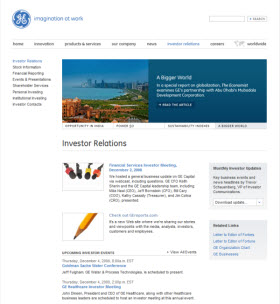When it comes to communicating with shareholders, many IR departments walk a fine line between the demand for more insight from shareholders, and the concern of legal and regulatory issues.
One of the issues with additional communications on the Investor Relations page is that its very placement suggests a formal and authoritative nature. One company is eliminating that problem by communicating with shareholders and customers alike via a separate website with its own domain name. This is a corporate blog, clearly linked from the main investor landing page.
GE reports
GE Reports is hosted at www.gereports.com. The link from the main site is in itself commendable, and the benefits of the additional site are numerous. The site is not specific or limited to investor communications. Instead, the site provides GE with a forum to publish its take on virtually any matter that arises.
The beauty of this idea is that it allows GE to not only respond to issues raised by the media or others, but also to express opinions and ideas proactively. In this way, GE can comment on both potential trouble and potential success in a way that helps to shape the discussion on such topics.
While a good idea in general, our concern here is with the value of such a site to Investor Relations departments. This value comes in many forms, both overt, and implicit. For example, the top post on this day notes the upcoming investor meeting for GE Capital including the fact that both a webcast and the materials will be available online. Such information not only reminds both investors and non-investors alike about an important upcoming event, it also demonstrates the company’s commitment to its investors.
GE Reports Answers
Perhaps the easiest way to see the enormous potential benefit of such an endeavor comes in the form of the Q&A that is posted regularly. The most recent had three questions posted. The first question was whether or not GE’s cash flow from operations minus asset sales is negative (and has been for years). I have heard this on occasion too. (I do not own GE stock, nor have any relationship with the company.) In the regular IR section of the official website, dispelling a rumor like this comes with some pretty thin ice to skate on. But here, a quick answer regarding GE’s cash flow is not only possible, but expected. (However, I am slightly disappointed that the answer did not directly answer the part of the question about asset sales.)
The next question asks about forecasting GE’s dividend after 2009. Again, this is a hot button issue that has many current investors nervous. The answer is a quick no, but more importantly it provides a link to a story about GE’s dividend, albeit the 2008 dividend. Such opportunities to steer investors in the direction of information that the company has already produced are tougher to come by on the more static IR pages since it requires anticipating not only the questions investors will have, but how they will be asked as well.
Good News
Finally, the GE Reports site gives the company the opportunity to highlight good news. Bad news is, as we all know, preferred by the mainstream media, and thus propagates on its own very well. Good news on the other hand is often considered “not news” and thus not disseminated on its own as well. A potential investor looking for how GE has been doing recently can read through multiple articles highlighting various company achievements and milestones. Of course, care needs to be taken to avoid becoming nothing but a cheerleading site, or investors and customers alike will quickly determine the site to be less useful for real information.
Best Practices
Obviously, setting up such a site isn’t something that is done on a whim, but this type of information source is clearly an advantage when done properly. Consider that press releases and regulatory filings cover much information, but to audiences who may not have the same interests as others. A report, or up to date information site like GE Reports can help your company reach yet another group of people. The upsides for both public perception and investor confidence are well worth the cost of looking into the concept further.




